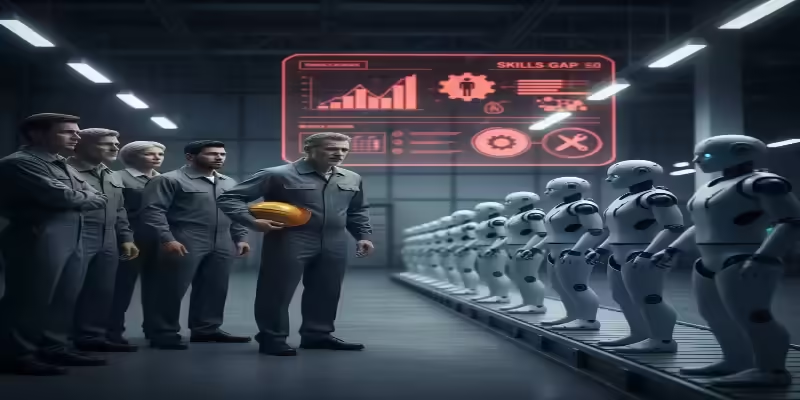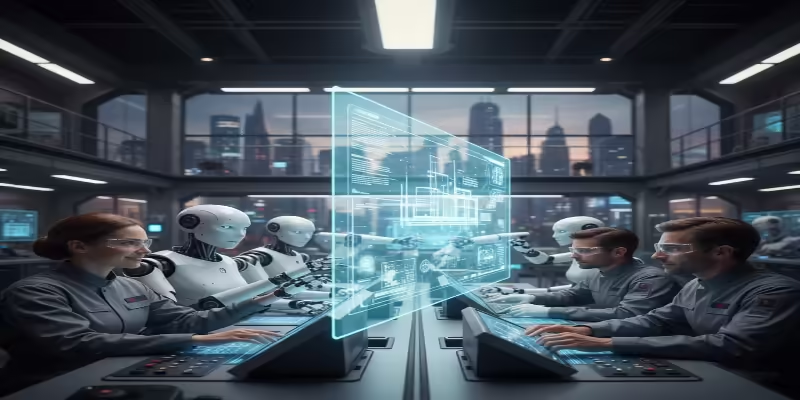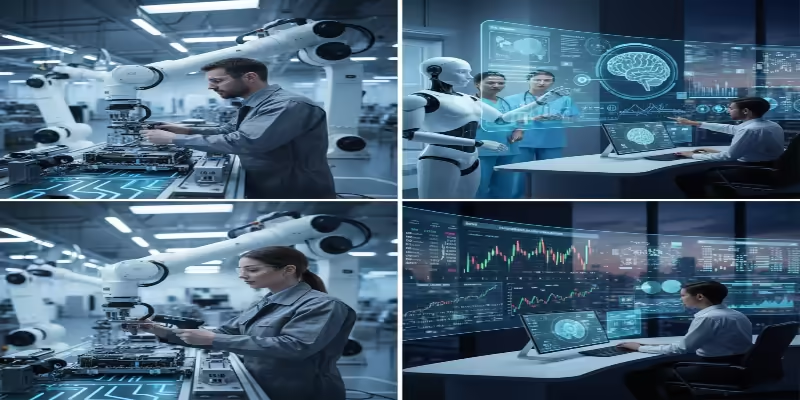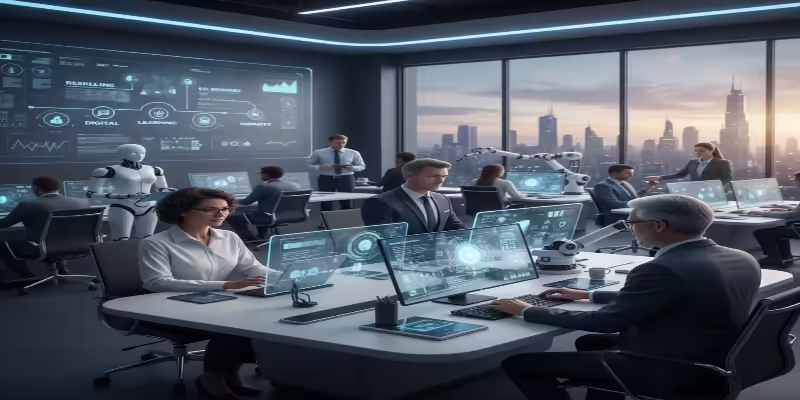Automation vs. Human Jobs: Finding the Balance in the Future Workplace
The workplace as we know it is changing fast. From manufacturing floors to office cubicles, automation is transforming the way we work, making some tasks faster, more efficient, and even safer. But with this rise of technology comes an important question: what happens to the human workforce? Will machines take over entirely, or is there a way to balance automation with human skills?
This is the core of discussions surrounding the future of work. As job automation becomes more widespread, businesses and employees alike must understand how to adapt, stay relevant, and work alongside machines rather than against them.
Understanding Job Automation
Before figuring out the impacts that automation has, it is crucial to know what job automation means. To be more precise, automation is the implementation of machines, smart systems, and programs in order to produce or deliver services that were done by humans.
Automation has always existed. The usage of robotic arms in factories along with software to handle tasks like payroll and inventory, has been the norm for a long time. Nevertheless, the latest developments in AI, machine learning, and robotics have led to the penetration of automation into knowledge work, customer service, and creative domains.
Some of the instances include the customer service automation with the help of chatbots, employing of AI algorithms to sift through large data sets, and automated systems can now even produce written work or provide medical diagnosis support. The widespread adoption of automation is changing the traditional labor market.
The Benefits of Job Automation
It is pretty clear that businesses, employees, and societies would massively benefit from job automation.
1. Increased Efficiency and Productivity
Mankind would have never created machines if they were only capable of working for a couple of hours and needed a lot of care and attention. Machines, however, can operate 24/7 without breaking down and producing the same amount of output as during the first hour of work. Hence, we could hardly argue that automation allows the execution of tasks in a much faster rate and with less mistakes than humans would do. In the production environment, robots can assemble products with a level of precision that is beyond human standards and at the same time not requiring the machines to stop for maintenance. In offices, AI software can perform tasks like sorting data, managing schedules, and generating reports almost instantaneously.
Such service leads to businesses being able to do more output using less resources which then result in a higher level of profit and competitive edge.
2. Safety and Risk Reduction
Automation is a wonderful solution for dangerous and monotonous jobs. Through automation, robots can manage tasks that involve the use of dangerous substances, work in extreme hot or cold temperatures, or perform heavy lifting of large equipment, hence reducing accidents at a workplace. Mistakes in finance and errors in data handling will be less when machines are taking over such tasks.
Moreover, by handing over the dangerous works to machines, automation is making it possible for human workers to concentrate on the more valuable, safer, and creative tasks.
3. Cost Savings
In most cases, the use of automation will lead to a reduction in operational costs in the long run. Machines do not need wages, health care, or any form of benefits, and they are capable of doing extensive repetitive works with little or no supervision. The money that a company saves can then be invested in research and development, employee training, and the improvement of working conditions and so on.
4. Innovation and Creativity
Mankind will likely be in charge of being imaginative and coming out with new ways of solving problems in the future world of work, which will be dominated by robots and automated systems. Skills that AI cannot possess, like caring, critical thinking, and strategizing will become more capital-intensive. The idea of turning over the tedious and boring parts of people’s jobs to machines will free up employees to become more creative, get involved in more strategies and, in turn, deliver better customer experiences.
Challenges of Automation on the Human Workforce

Certainly, where automation draws advantages, it still is not without its problems which refuse to be overlooked.
1. Job Displacement
As an aspect singled out from a variety of concerns, the possibility of human workers being replaced entirely by machines is the issue most talked about. The jobs that are at risk are those which are performed with a complete set of rules accompanied by the execution of repetitive tasks e.g. data entry, assembly line, or basic customer support. Consequently, there could be unemployment, underemployment, and fears among the workforce which, in turn, may result in them not feeling secure enough to use their skills.
Nevertheless, history is full of examples when technological inventions ended up not killing the employment but rather reshaping positions and people had to adapt and learn new skills.
2. Skills Gap
The growth of automation results in changes in the demand for different skills sets. Skills such as digital literacy, data analysis, AI comprehension, and problem-solving are becoming non-negotiable whereas the manual or routine skill areas may find themselves less valuable. One of the major challenges for the human workforce is the disparity in the skills that the workers have and the skills that the employers require.
Training and re-training activities are the cornerstones that guarantee employees an employability status in the changing landscape.
3. Economic and Social Implications
The phenomenon of job automation on a large scale may be a factor leading to the widening of the economic gap if the benefits are only reaped by the businesses and the highly skilled workers. Workers with lower incomes who are in jobs that are at risk of automation may find it increasingly difficult to maintain their financial stability, therefore, a source of social problems. There is a need for the government, organizations, and educational institutions to come together and coordinate in an efficient manner to make sure the transition is seamless.
Finding the Balance: Humans and Machines Working Together

It is not the solution to fight against automation, neither is it to entirely replace humans. What it is about is finding a middle ground. Machines' effectiveness will be combined with the inventiveness, emotions, and discretion of humans and as a result, the most efficient workplaces will prevail in the future of work.
Augmentation Instead of Replacement
Automation is the enhancement of human capabilities, not their replacement. The case of AI is just a perfect example of this, wherein AI takes care of the entire data handling but still requires human intervention in terms of interpretation, making the right decisions, along with providing context.
At the same time, the implementation of a chatbot in customer service would result in the handling of simple requests, and thus, customer service representatives would be at liberty to manage the difficult and emotional cases. Artificial intelligence can propose a diagnosis when it comes to healthcare technologies; however, it is the doctor's experience and knowledge of the patient's condition that determines the final decision. This synergy guarantees that human beings remain at the core of work.
Reskilling and Lifelong Learning
The human workforce alongside automation will be successful only if it continually updates its learning portfolio. A combination of different programs: Upskilling, vocational and technical education in new areas of technology is absolutely necessary. People working on the cutting edge of technology will be the ones empowered to take full advantage of the synergism between AI and human intelligence instead of falling prey to it.
Lifelong learning will not only become a career advantage but a necessity in a highly automated workplace.
Redefining Job Roles
Automation gives impetus to businesses to reassess job roles. Employees are allowed to transform their creative skills, instead of doing the same monotonous tasks. For example:
Data entry clerks can upskill to become data analysts.
Factory workers can monitor the robotic machinery.
Customer care agents can improve the client experience by managing complex inquiries and streamlining processes.
Most importantly, the progression ensures that human beings keep providing what they are best at, simply, routine works are taken over by automation.
Examples of Successful Human-Machine Collaboration

Manufacturing
Robot use in factories to do assembly line work that is repetitive and draining has been one of the great improvements. While human workers still perform quality control, maintenance, and process improvement through their skills. This not only reduces the number of injuries but also increases efficiency and allows the application of critical thinking skills by humans.
Healthcare
AI-powered diagnostic instruments have made it easier for doctors to detect diseases accurately and in less time. While machines are busy with the task of image processing and pattern recognition, physicians are the ones who interpret the results and make the final decision based on their experience and judgement, which machines cannot replicate.
Finance
Fully automated software, for instance, can perform operations, detect fraudulent activities, and generate reports, whereas financial analysts can be involved in the development of strategies, managing client relationships, and financial planning. The combined use of robots and humans allows traders to have an advantage in making decisions that are not only quicker, but also more accurate and more informed.
Customer Service
In most cases, customers have a set of simple questions that chatbots can quickly resolve; however, the human personnel are the ones to handle the complaints, solve complex problems and interact with the customers on an emotional level.
Preparing for the Future of Work

The future of work is not about humans replacing machines but rather about working together. Companies and employees will need to adjust to a combined model in which technology takes care of standard tasks while people concentrate on the areas of thinking, innovation, and emotional intelligence.
For Organizations
Pour money into the programs that train and reskill people.
Spot the tasks that can be automated without any risk of human judgment.
Make a culture that champions collaboration between humans and machines.
For Employees
Build up your digital skills and learn the needed technical skills.
Commit yourself to lifelong learning and always be ready to change.
Concentrate on the skills that cannot be easily duplicated by machines like creativity, empathy, and strategic thinking.
For Policymakers
Support the formation of educational systems that provide both digital and soft skills.
Guarantee the establishment of safety nets for workers that automation will displace.
Motivate the fair distribution of the training and reskilling programs.
The Role of Ethical Automation
As the use of automation continues to expand, the importance of ethical considerations keeps growing. Corporations are required to make sure that the job automation is carried out in a responsible way. The choices made about automation should focus not only on productivity and cost reduction but also on the welfare of the employees, the impact on the community, and the aspect of justice.
Ethical automation means:
Not employing algorithms that discriminate against anyone.
Keeping the decision made by automated systems open for human inspection.
Helping displaced workers with retraining and providing them with jobs in other sectors.
By operating ethically, firms can integrate technology with social responsibility, thereby, developing the kind of workplaces that are advantageous to both humans and machines.
Conclusion: Embracing Balance in the Future Workplace
Automation will rise and take-over the world one day, it is just a matter of time. Technology will keep on taking over the monotonous, boring, or risky, jobs while humans will concentrate on the creative part, planning, and empathy. The future work is not about substitution but rather dialog.
Automating jobs can bring the company performance to higher levels by simplifying the tasks, saving time and money. However, the human employees are still necessary. People add reasoning, and emotional skills, and invent those are the very qualities that machines cannot do. Through the acceptance of collaboration, requalification, and moral conduct we are able to establish the productive workplaces, where people coexist with the machines.
In the end, the point is not to decide which is better humans or automation but rather which one to use in combination with the other for a future workplace that is more efficient, more innovative and still human-centered.